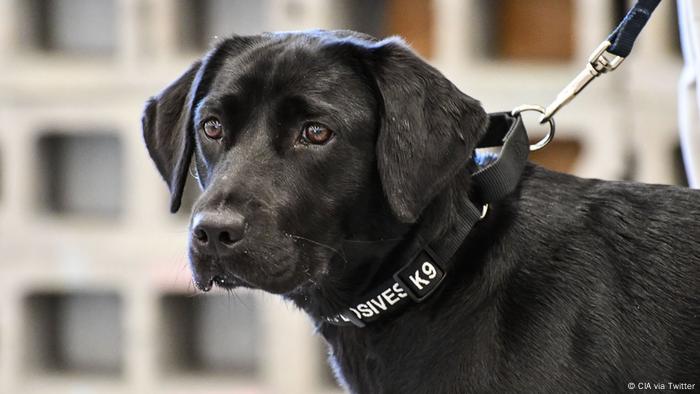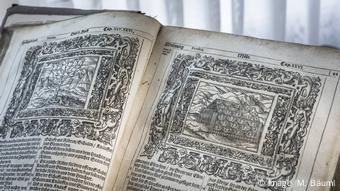Celebrating the history of the 'dog ear' bookmark on World Book Day
FRIDAY WAS WORLD BOOK DAY
The practice of folding the corners of one's book to mark a page has a name — and has been done for centuries.
A PRACTISE I CAN LAY CLAIM TOO DOING TOO OFTEN

This type of fold is known as a dog ear
Even as e-reading devices have gained popularity in recent years, many bookworms still prefer reading a good, old-fashioned printed book. April 23 is World Book Day and studies have shown that people are reading more than ever during the pandemic. Those who prefer to buy second-hand books may have come across private sellers' creative advertisements of the item's condition. "With a few dog ears here and a couple of torn pages, but otherwise in impeccable condition" one might read in a seller's description.
A dog ear is a colloquial term for the folded down corner of a book page — the way some of us, when we don't have a bookmark at hand might keep our place. The name, as one might guess comes from the folded page's resemblance to the floppy ears of most domestic dog breeds.
Irma Pince, the librarian at Hogwarts School of Witchcraft and Wizardry in the Harry Potter novels, posted an ominous warning to book defilers. "A warning if you rip, tear, shred, bend, fold, deface, disfigure, smear, smudge, throw, drop, or in any other manner damage, mistreat, or show lack of respect towards this book, the consequences will be as awful as it is within my power to make them."

Easy to see why this type of bookmark is called a dog ear
In reality, a torn page won't result in wizardly punishment, but it can come with consequences. At public libraries, book lenders who tear or rip a page, even accidentally, may be responsible for property damage and might have to provide a replacement or pay some form of compensation.
In private circles, books borrowed and returned in a damaged condition can jeopardize the continuation of friendships. Books have value, and for some, it's an emotional one.
Irreparable damage?
Unfortunately, even a smoothed out dog-ear leaves its mark on a book page for all of eternity. Are dog-ears irreparable? "In a nutshell: yes!" says Frauke Grenz from Papierwerkstatt Friedrichshagen, which restores and repairs books. "The crease injures the fibers of the paper, which unfortunately cannot be repaired."
Grenz and her team restore books, smoothing and binding pages and repairing spines. In addition to private individuals, the workshop also collaborates with libraries. They can therefore be required to restore, for example, a Bible from 1737. "With books that old, dust and dryness are aggravating factors." A dog-eared book can break when bent back if the paper is rotten, the expert told DW.

The librarian of Harry Potter's Hogwarts dealt swift punishment for damaging books
Her customers often come to the workshop with books that at first glance are not worth the trouble of refurbishing. She then initially recommends buying the book second-hand somewhere. "But if there's a dedication inside or it was left by someone's mother, the emotional attachment to the book is often so great that we get to work."
Fortunately, there are some tricks for those who want to smooth out their books' dog ears. "Ironing is a great idea if done carefully and with some blotting paper in between to dissipate the heat," recommends Grenz. However, no matter what one does, dog ear traces will not disappear completely. Grenz doesn't find this problematic: "It doesn't detract from the content. It's more important to me that the binding feels good in the hand and is not worn."
Dog ears in the 17th century
It's impossible to clearly date the first mention of a dog ear as it refers to a bent page in the history of literature. In 1838, the Grimm brothers began to compile terms for the German dictionary published in 1854, which included a mention of the "Eselsohr" or "donkey's ear," which is the German equivalent of the dog ear, as "a mark in a read book made by bending a corner of the page."
And as early as the 17th century, the poet Andreas Gryphius mentioned a dog ear in one of his writings. Although Johannes Gutenberg's letterpress printing technique was already widespread by the 15th century, in the 17th century, many people still could not afford to buy books. Reading meant getting an education and in those days, an education was a luxury. Even then, some well-off individuals apparently still bent the corners of their precious pages.

The dog ear was mentioned as early as the 17th century although few had books then
Not even digitization has fully eradicated the dog ear concept. As a tribute to analog reading, some e-book readers have digital dog-ears built into them. With a tap on the screen, a triangular bookmark appears at the corner of the screen.
That a bookish term presumably coined in the 17th century in Germany is still used today is something to celebrate. As difficult as it may be for book lovers and book aesthetes to accept bent page corners, the dog ear must respected as a part of centuries of reading culture.
This article was translated from German by Sarah Hucal.

This type of fold is known as a dog ear
Even as e-reading devices have gained popularity in recent years, many bookworms still prefer reading a good, old-fashioned printed book. April 23 is World Book Day and studies have shown that people are reading more than ever during the pandemic. Those who prefer to buy second-hand books may have come across private sellers' creative advertisements of the item's condition. "With a few dog ears here and a couple of torn pages, but otherwise in impeccable condition" one might read in a seller's description.
A dog ear is a colloquial term for the folded down corner of a book page — the way some of us, when we don't have a bookmark at hand might keep our place. The name, as one might guess comes from the folded page's resemblance to the floppy ears of most domestic dog breeds.
Irma Pince, the librarian at Hogwarts School of Witchcraft and Wizardry in the Harry Potter novels, posted an ominous warning to book defilers. "A warning if you rip, tear, shred, bend, fold, deface, disfigure, smear, smudge, throw, drop, or in any other manner damage, mistreat, or show lack of respect towards this book, the consequences will be as awful as it is within my power to make them."

Easy to see why this type of bookmark is called a dog ear
In reality, a torn page won't result in wizardly punishment, but it can come with consequences. At public libraries, book lenders who tear or rip a page, even accidentally, may be responsible for property damage and might have to provide a replacement or pay some form of compensation.
In private circles, books borrowed and returned in a damaged condition can jeopardize the continuation of friendships. Books have value, and for some, it's an emotional one.
Irreparable damage?
Unfortunately, even a smoothed out dog-ear leaves its mark on a book page for all of eternity. Are dog-ears irreparable? "In a nutshell: yes!" says Frauke Grenz from Papierwerkstatt Friedrichshagen, which restores and repairs books. "The crease injures the fibers of the paper, which unfortunately cannot be repaired."
Grenz and her team restore books, smoothing and binding pages and repairing spines. In addition to private individuals, the workshop also collaborates with libraries. They can therefore be required to restore, for example, a Bible from 1737. "With books that old, dust and dryness are aggravating factors." A dog-eared book can break when bent back if the paper is rotten, the expert told DW.

The librarian of Harry Potter's Hogwarts dealt swift punishment for damaging books
Her customers often come to the workshop with books that at first glance are not worth the trouble of refurbishing. She then initially recommends buying the book second-hand somewhere. "But if there's a dedication inside or it was left by someone's mother, the emotional attachment to the book is often so great that we get to work."
Fortunately, there are some tricks for those who want to smooth out their books' dog ears. "Ironing is a great idea if done carefully and with some blotting paper in between to dissipate the heat," recommends Grenz. However, no matter what one does, dog ear traces will not disappear completely. Grenz doesn't find this problematic: "It doesn't detract from the content. It's more important to me that the binding feels good in the hand and is not worn."
Dog ears in the 17th century
It's impossible to clearly date the first mention of a dog ear as it refers to a bent page in the history of literature. In 1838, the Grimm brothers began to compile terms for the German dictionary published in 1854, which included a mention of the "Eselsohr" or "donkey's ear," which is the German equivalent of the dog ear, as "a mark in a read book made by bending a corner of the page."
And as early as the 17th century, the poet Andreas Gryphius mentioned a dog ear in one of his writings. Although Johannes Gutenberg's letterpress printing technique was already widespread by the 15th century, in the 17th century, many people still could not afford to buy books. Reading meant getting an education and in those days, an education was a luxury. Even then, some well-off individuals apparently still bent the corners of their precious pages.

The dog ear was mentioned as early as the 17th century although few had books then
Not even digitization has fully eradicated the dog ear concept. As a tribute to analog reading, some e-book readers have digital dog-ears built into them. With a tap on the screen, a triangular bookmark appears at the corner of the screen.
That a bookish term presumably coined in the 17th century in Germany is still used today is something to celebrate. As difficult as it may be for book lovers and book aesthetes to accept bent page corners, the dog ear must respected as a part of centuries of reading culture.
This article was translated from German by Sarah Hucal.
No comments:
Post a Comment